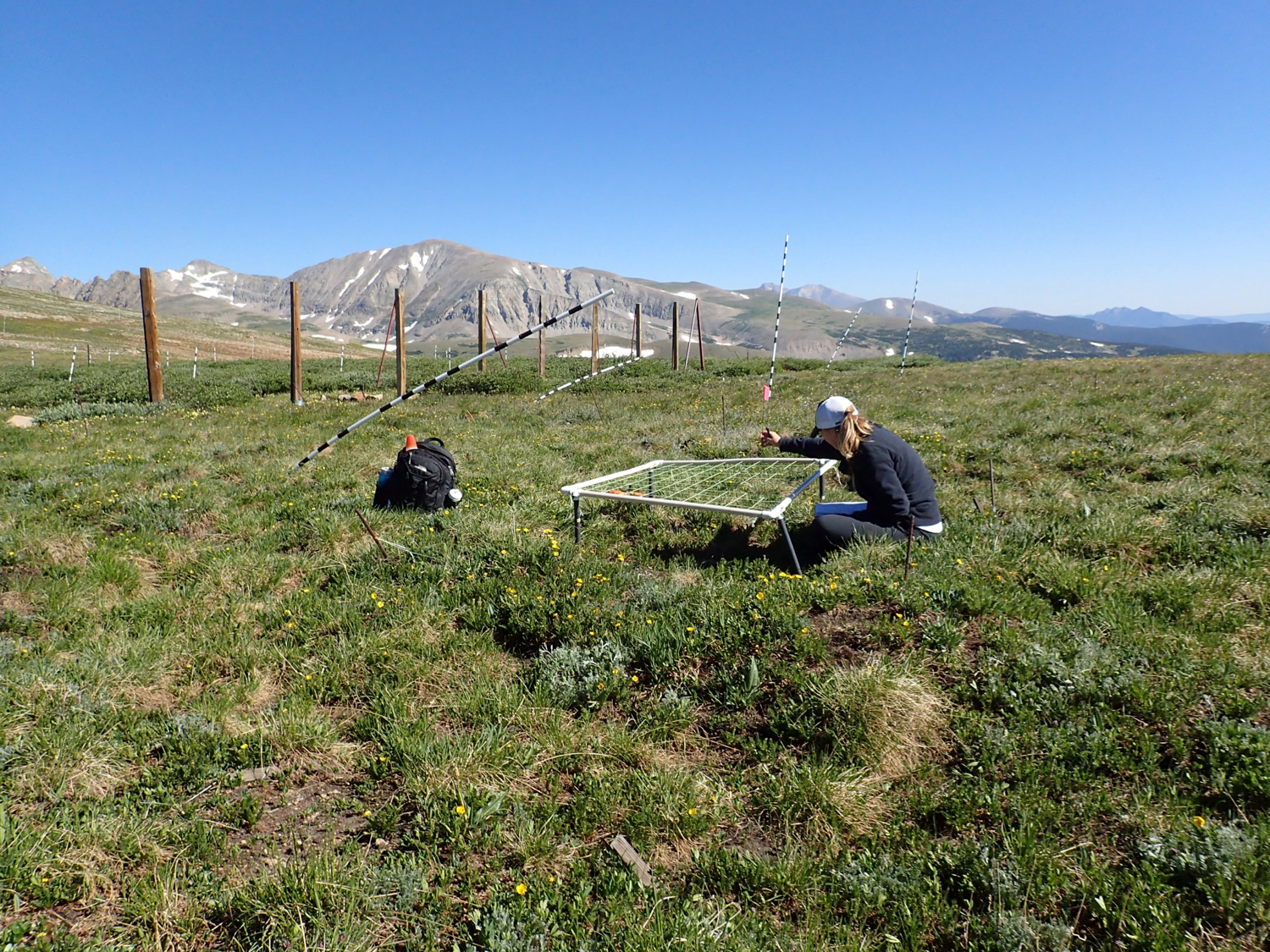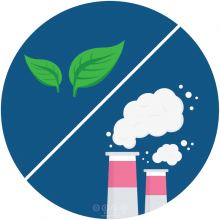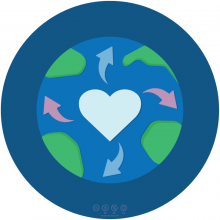A Scientist’s Take On Communication Training

With such a polarizing, politicized, and frightening subject, it’s easy to slide into contentious conversation when talking about climate change. I often get frustrated if others don’t share the urgency I feel about this topic, but this is not the right tone to take if you want to encourage people to take action. So what’s the best way to approach this subject, and how do we get our communities more involved in finding solutions to climate change? At a conference this past year, I participated in a workshop focused on climate change communication, and I’m here to share the strategies I learned for having productive conversations about climate change.
The current buzz statistic is that 70% of Americans acknowledge that climate change is happening and express some worry [1]. However, research by the National Network for Ocean and Climate Change Interpretation (NNOCCI) in collaboration with FrameWorks Institute has found that most Americans still don’t understand the science behind what’s happening to the earth’s climate, and this misunderstanding might be why many are not yet engaging in climate change mitigation. It’s tough to talk about solutions to climate change without a good grasp on what’s actually going on, and this was a great reminder for me that beyond – and even within – my scientific community, there is a lot of misinformation out there about climate change.
To solve this problem, NNOCCI and FrameWorks came up with some clever metaphors to help people understand climate change and to make connections between their actions and why the climate is changing. BUT FIRST! What is climate change? In two sentences – since the industrial revolution, humans have burned more and more fossil fuels (coal, oil, and natural gas), resulting in a build-up of CO2 in the Earth’s atmosphere. This extra CO2 acts as a “heat-trapping blanket”, which disrupts the Earth’s climate [2]. You may have noticed that I avoided the term ‘greenhouse effect’. NNOCCI actually found that ‘heat-trapping blanket’ was a stronger metaphor than anything having to do with a greenhouse, which people intuitively think of as a nice, sunny place that’s good for plants.
Here are some other metaphors that tested well with the public, and good ones to keep in your back pocket if you’re struggling to find a concise way to explain the science of climate change:
Regular & Rampant CO2
“‘Regular’ carbon dioxide is used and created by normal life processes, but ‘Rampant’ carbon dioxide comes from burning fossil fuels for energy. We need to reduce Rampant CO2. It’s getting out of control.” [2] Understanding this distinction – Regular CO2 as plant food and Rampant CO2 as pollution – is a major key to debunking a lot of misinformation about climate change and what it means for the natural world. This metaphor also provides justification for the everyday energy efficient activities we can do to help the planet.
Fig. 1 – Regular & Rampant CO2 is an important distinction to make when trying to explain climate change. (source: NNOCCI’s Reframe Cards)

The Ocean is the Climate’s Heart
“Just as a heart circulates blood and regulates the body’s temperature, the ocean controls the circulation of heat and moisture throughout the climate system.” [2] This metaphor helps people understand the difference between climate (long term averages and patterns in heat and moisture movement) and weather (specific events resulting from the functioning of the climate), and why some places might be getting warmer and wetter while others are drier and cooler.
Fig. 2 – The Ocean is the Climate’s Heart. (source: NNOCCI’s Reframe Cards)

Ocean Acidification is the Osteoporosis of the Sea
“Ocean acidification changes the chemistry of the ocean and causes ‘osteoporosis of the sea,’ which prevents animals at the bottom of the food chain from building and maintaining the protective shells they need to survive.” [2] With this metaphor, you can draw people into how we impact the environment, and specifically the impact of CO2 on the ocean as an important part of the earth’s climate.
Fig. 3 – Osteoporosis of the Seas as a metaphor for ocean acidification. (NNOCCI’s Reframe Cards)

If you’re a scientist like me, you might be surprised at the simplicity of these metaphors, but don’t forget your audience! Ensuring you’re on the same page before getting to more advanced topics and finding common ground are important for any successful communication. NNOCCI cited the following as ways to find common ground about climate change without frightening people away from a problem that feels too big to solve:
-
Focus on the urgency of climate change rather than treating climate change as a crisis. Avoiding a crisis tone is actually a better way to get people engaged over the long-term.
-
Protecting our resources, our land, and our people.
-
Taking responsibility – we have a chance to impact the future, but that future depends on us.
With tools to explain the mechanisms of climate change, and some easy topics on which to find common ground, you can shift the conversation towards solutions. But first! It’s important to remember that most people are very aware of the mismatch between the scale of individual-based solutions – like riding your bike more – and the scale of global climate change. I’m sure it goes without saying, but you want to avoid pointing the finger. Rather, offer examples of positive change that’s already happening. This way you can allow others to think of ways they can be involved without feeling like the weight of the problem falls on their shoulders alone. These individual solutions are undoubtedly still important, but you’re more likely to get further in conversation if you focus on collective solutions; engaging with your community is a great place to start the process of systemic change necessary to reduce our impact on this planet.
NNOCCI provides what they call a ‘solutions suite’ of examples at different scales that you can draw on. Starting in your community can help initiate systemic change in the way we treat the natural world. Rather than getting sucked into the doom and gloom of climate change, use rhetoric to highlight positive change and the people around the world that are already doing great work (see this TLS post to learn about Boston’s efforts). This will more likely encourage others to do the same.
I took away a lot from these key points, and I hope you learned something too. For more information, videos, and the research supporting these pointers, check out https://climateinterpreter.org/
Evelyn Beaury (Eve) is a PhD candidate at the University of Massachusetts Amherst. She studies the diversity and distribution of invasive plants, their impacts, and how they interact with global change. In addition to research, Evelyn is passionate about outreach and science communication. She is the current vice president and a writer/editor for the graduate student blog That’s Life [Science], which strives to share all aspects of the life sciences with its readers in a fun and creative way.
More Blog Posts
 Cut through Confusion with Appeals to Protection and ResponsibilityCut through Confusion with Appeals to Protection and Responsibility September 07 2016 This is the third in a series about framing ocean and climate change. Advocates and experts are familiar with common—but often untrue—tropes about our environment. How can we cut through them and communicate in a way that deepens understanding about the complex [READ MORE]
Cut through Confusion with Appeals to Protection and ResponsibilityCut through Confusion with Appeals to Protection and Responsibility September 07 2016 This is the third in a series about framing ocean and climate change. Advocates and experts are familiar with common—but often untrue—tropes about our environment. How can we cut through them and communicate in a way that deepens understanding about the complex [READ MORE] Newly Released: The Drawdown ReviewNewly Released: The Drawdown Review by Elizabeth Bagley, May 22 2020 Reprinted with permission from The Drawdown Review by Project Drawdown © 2020 Project Drawdown. All rights reserved. In the spring of 2017, Project Drawdown released its inaugural body of work on climate solutions with the publication of the best-selling book Drawdown and [READ MORE]
Newly Released: The Drawdown ReviewNewly Released: The Drawdown Review by Elizabeth Bagley, May 22 2020 Reprinted with permission from The Drawdown Review by Project Drawdown © 2020 Project Drawdown. All rights reserved. In the spring of 2017, Project Drawdown released its inaugural body of work on climate solutions with the publication of the best-selling book Drawdown and [READ MORE] Lessons from COP23 – The Power Of CommunityLessons from COP23 – The Power Of Community Allison Arteaga, November 21 2017 Last week, the world’s leading voices on climate change gathered in Bonn, Germany for the 23rd Conference of the Parties (COP23) to the United Nations Framework Convention on Climate Change (UNFCCC). Since last year’s conference in Marrakech, the political [READ MORE]
Lessons from COP23 – The Power Of CommunityLessons from COP23 – The Power Of Community Allison Arteaga, November 21 2017 Last week, the world’s leading voices on climate change gathered in Bonn, Germany for the 23rd Conference of the Parties (COP23) to the United Nations Framework Convention on Climate Change (UNFCCC). Since last year’s conference in Marrakech, the political [READ MORE] Museums Mobilizing Climate ActionMuseums Mobilizing Climate Action Billy Spitzer, August 06 2018 (Excerpted from a commencement speech for the Harvard Extention School Museum Studies Program) The Role of Museums In Tackling Climate Change At the New England Aquarium, I spend most of my time working at the intersection of museums and sustainability. About 10 years ago, we realized [READ MORE]
Museums Mobilizing Climate ActionMuseums Mobilizing Climate Action Billy Spitzer, August 06 2018 (Excerpted from a commencement speech for the Harvard Extention School Museum Studies Program) The Role of Museums In Tackling Climate Change At the New England Aquarium, I spend most of my time working at the intersection of museums and sustainability. About 10 years ago, we realized [READ MORE] National Network for Ocean and Climate Change Interpretation (NNOCCI) Impacts After 5 YearsNational Network for Ocean and Climate Change Interpretation (NNOCCI) Impacts After 5 Years by Sarah-Mae Nelson, MS, CIG/CIT, February 13 2016 Since 2009, the National Network for Ocean and Climate Change Interpretation—better known as NNOCCI—has been a collaborative effort to raise the discourse around climate change and ocean acidification. Led [READ MORE]
National Network for Ocean and Climate Change Interpretation (NNOCCI) Impacts After 5 YearsNational Network for Ocean and Climate Change Interpretation (NNOCCI) Impacts After 5 Years by Sarah-Mae Nelson, MS, CIG/CIT, February 13 2016 Since 2009, the National Network for Ocean and Climate Change Interpretation—better known as NNOCCI—has been a collaborative effort to raise the discourse around climate change and ocean acidification. Led [READ MORE]